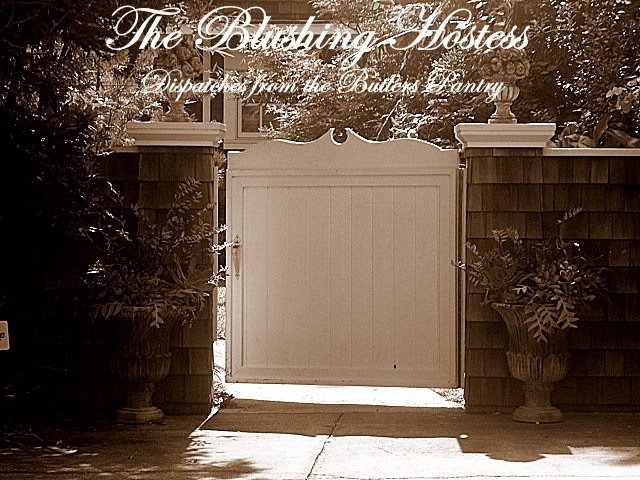Whenever I am congratulating myself for not having capitulated to paper napkins, and some terrifying bin in which they reside on the table permanently, not to mention paper plates, this book always has a way of reeling me in: It instructs and deconstructs the Hostess so that one never gets to comfortable: The book is always there, watching me, and all the while whispering, "There is still more to be done here." The thing has obsequious gaze.
This one phrase regarding dining tables in private homes in Letitia Baldridge's second revision always gets me: "Even the table has changed. Plastic mats and polyester no-iron mats are seen everywhere. If a young hostess today were to be shown a forty-foot long white damask banquet cloth, she would probably say incredulously, 'What's that?'"
I seriously laugh for a good five minutes every time I read that phrase in the chapter entitled, Household Management in a Serventless Society (aka, from the tone of the chapter: What's to Become of Us?!).
Where they so common, ever, that hostesses looked up from their inviting desks and made a note to do something about the cloth that is roughly three building stories long? And following a regular table seating expectation for a two sided dinner setting, would have comfortably seated fifty? You know, because so many people had dining rooms that big, tables that long, or ambitious plans to invite hordes to enjoy pistou and daube with them ever so regularly?
Roughly, the room would look like this:

This is the White House State Banquet Hall, ca. 1904, as expanded sixty percent to seat 100 persons for dining in a number of seating arrangements including two long tables.
Amy (RIP), Letitia: If one had the capacity, it is indeed unlikely they were going to take to the presses themselves to see to it the wrinkles were out of the cloth. And while the text is decidedly aspirational it was indeed intended, even originally, by purchase for the masses, causing the Hostess to believe we are not the first generation to have snickered at phrases such as these. Nonetheless, on countless other points the book is indispensable so I in no way wish to discredit.
Locally, there are any number of grand homes dating from the colonial period forward, (rebuilding largely begun just after the Revolutionary War, which saw the burning of Bedford by British troops, concluded). I dare say, then, and in every period since, in a community which could have managed, a dining room of this stature was rare. Furthermore, when the places did exist many were modified to reduce the dining spaces. Everyone knows and can imagine these sort of places, why, you can tour them: The Breakers, Rosecliff.
A privately held local example, Linden Farm, erected in 1928 and at nearly 14,000 square feet, has plenty of room for everything. You can have this estate and renovate to get the length of dining room, for $28 million. So the table cloth then, will not be a problem, right?
I like to think many hostesses of many era's including my own would see a damask forty-footer, know exactly what it was, and how to conquer it (by cutting it up for drapes a la Carol Burnette as Scarlett O'Hara). Come on. This is what you get when a White House social secretary revises an etiquette text. Honestly, the 50th Anniversary Edition, revised by Nancy Tuckerman, is a mite more effective and useful, possibly than Letitia's two revisions ever were.
Even then (the original text was completed in 1951, so let's assume for argument that Amy refers to the first half of the 20th century), I certainly believe people valued realism, and surely the book would have sold more copies if it had indeed addressed the lives of good, but not Astor-esque hostesses and household managers with something other than disdain.
No word of a lie, I just Googled this and the first forty eight entries referred to plastic banquet cloths or something that comes in a roll. Indeed it seems we have slipped at least on the fabric portion of the large tablecloth. Likely, you would need to commission a damask one now or live with that hideous polyester fabrication hotels use.
While the message is derived of a distaste for what these social hall monitors deemed a failure of our civilization's hostesses to maintain taste, care, and decorum, the message is none the less valuable: Old standards are good standards for entertaining, but they are harder, and in these times, probably as in all, the roads less taken.





1 comment:
Great post.
Could you please recommend a good book on etiquette that is geared to children?
Post a Comment